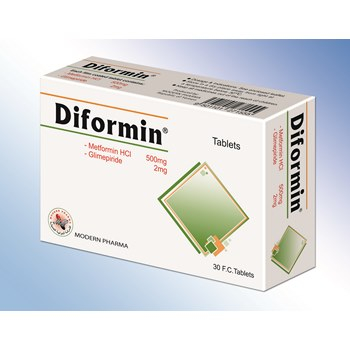DIFORMIN 500-2
- Diformin® is a medicine which contains two components: Metformin
Hydrochloride and Glimepiride.
- Metformin Hydrochloride is an oral antidiabetic (biguanide) agent. Its
mechanism of action is differs from those of sulfonylurea, where it decreases
hepatic glucose production, decreases intestinal absorption of glucose and
improves insulin sensitivity (increase peripheral glucose uptake and utilization).
It doesn’t produce hypoglycemia and doesn’t change insulin secretion.
- Glimepiride is a sulfonylurea hypoglycemic agent and act by stimulation of
insulin release from functioning pancreatic beta cells and increases sensitivity of
peripheral tissues to insulin.
- Absorption: Metformin hydrochloride is slowly and incompletely absorbed
from the gastrointestinal tract, inverse Glimepiride where it completely
absorbed from the gastrointestinal tract. The peak plasma concentrations for
both occur between 2- 3 hours, and bioavailability from 50- 60% for
metformin.
- Plasma protein binding: Metformin’s plasma protein binding is negligible, and
it excreted unchanged in urine, where the plasma elimination half life range
from about 2 -6 hours.
Glimepiride is highly bound to plasma proteins and is completely metabolized.
The half life after multiple doses is about 9 hours and ( 60%) of dose is
eliminated in the urine and 40% in the feces.


